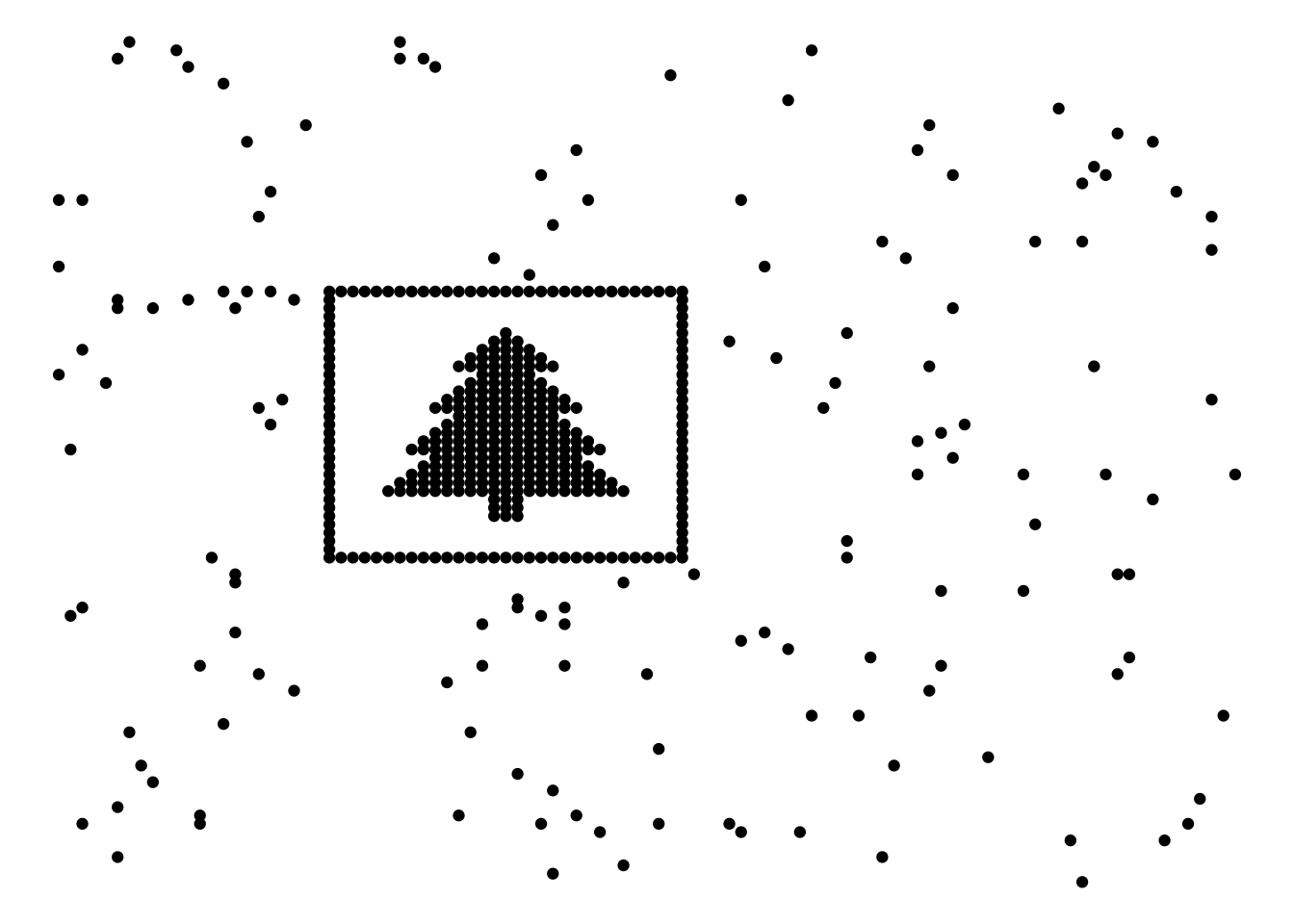Restroom Redoubt
Part 1
When I was almost done I realized I could’ve just multiplied the vectors by 100 then not needed a loop. Oh well. Easy enough.
m <- matrix(list(), nrow = 103, ncol = 101)
dt <- mdt
for(i in 1:100) {
dt <- purrr::map(dt, \(x) {
p <- x$p + x$v
p[1] <- p[1] %% ncol(m); if (p[1] == 0) p[1] <- ncol(m);
p[2] <- p[2] %% nrow(m); if (p[2] == 0) p[2] <- nrow(m);
list('p' = p, 'v' = x$v)
})
}
p <-
dt |>
purrr::map(\(x) x$p |> matrix(ncol = 2) |> as.data.frame()) |>
purrr::list_rbind() |>
setNames(c('col', 'row')) |>
dplyr::select('row', 'col')
mid_row <- ceiling(nrow(m) / 2); mid_col <- ceiling(ncol(m) / 2);
one <- p[p$row < mid_row & p$col < mid_col,] |> nrow()
two <- p[p$row < mid_row & p$col > mid_col,] |> nrow()
three <- p[p$row > mid_row & p$col < mid_col,] |> nrow()
four <- p[p$row > mid_row & p$col > mid_col,] |> nrow()
prod(one, two, three, four)[1] 228421332Part 2
Ugh. mistlecode::coords_to_matrix() isn’t working. I guess I’ll use {ggplot}. Figuring out how to identify the tree was annoying. I tried clicking through the first 500 iterations with {ggplot} but that wasn’t going anywhere. I took a bit but I figured that the tree would probably have either high or low density in terms of points vs white space. Took a gander and just ran a loop until the initial state was repeated then checked the max and min densities. Sure enough. Max density it was.
dt1 <- purrr::map(mdt, \(x) {
p <- x$p + x$v
p[1] <- p[1] %% ncol(m); if (p[1] == 0) p[1] <- ncol(m);
p[2] <- p[2] %% nrow(m); if (p[2] == 0) p[2] <- nrow(m);
list('p' = p, 'v' = x$v)
})
i <- 2
repeat {
dt <- purrr::map(mdt, \(x) {
p <- x$p + (x$v * i)
p[1] <- p[1] %% ncol(m); if (p[1] == 0) p[1] <- ncol(m);
p[2] <- p[2] %% nrow(m); if (p[2] == 0) p[2] <- nrow(m);
list('p' = p, 'v' = x$v)
})
if (identical(dt, dt1)) break
dt <-
dt |>
purrr::map(\(x) x$p |> matrix(ncol = 2) |> as.data.frame()) |>
purrr::list_rbind() |>
setNames(c('col', 'row'))
f <- nrow(unique(dt)) / prod(dim(m))
if (f < filled[1]) {
filled[1] <- f
which_filled[1] <- i
} else if (f > filled[2]) {
filled[2] <- f
which_filled[2] <- i
}
i <- i + 1
}purrr::map(1:2, \(i) {
dt <- purrr::map(mdt, \(x) {
p <- x$p + (x$v * which_filled[i])
p[1] <- p[1] %% ncol(m); if (p[1] == 0) p[1] <- ncol(m);
p[2] <- p[2] %% nrow(m); if (p[2] == 0) p[2] <- nrow(m);
list('p' = p, 'v' = x$v)
})
dt |>
purrr::map(\(x) x$p |> matrix(ncol = 2) |> as.data.frame()) |>
purrr::list_rbind() |>
setNames(c('col', 'row')) |>
ggplot2::ggplot() +
ggplot2::geom_point(ggplot2::aes(x = col, y = -row)) +
ggplot2::theme_void()
})[[1]]
[[2]]